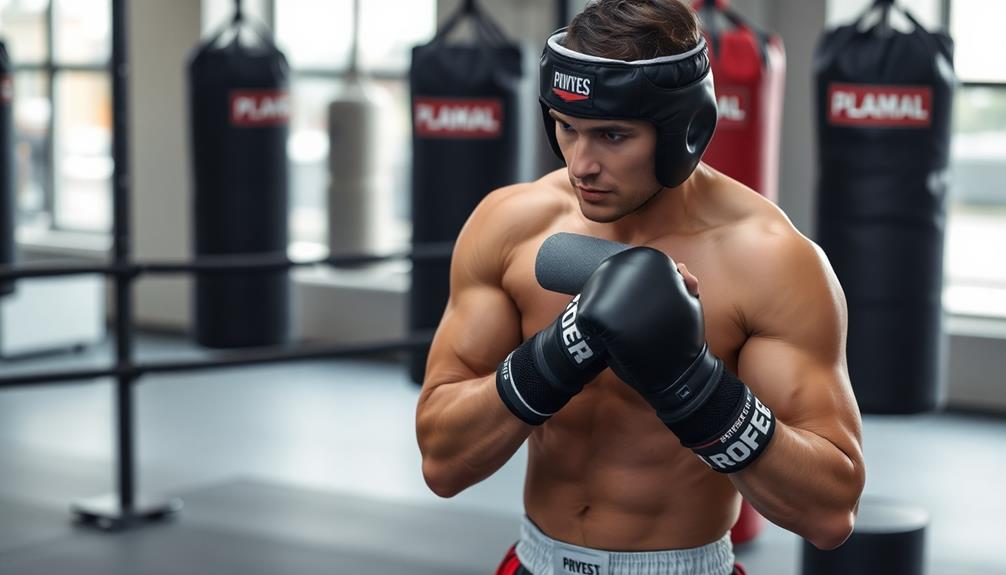Resistance training can greatly enhance your boxing skills by improving punching power, defense, and endurance. You'll build muscle, boost calorie burning, and strengthen bones, joints, and coordination. Focus on upper body exercises like push-ups and pull-ups, using resistance bands and dumbbells. Don't neglect lower body power with squats and lunges, incorporating resistance bands and plyometrics. Core stability is pivotal, so include planks and rotational movements with medicine balls. Use essential equipment like gloves, heavy bags, and jump ropes for a well-rounded workout. As you progress, gradually increase weight and intensity while maintaining proper form. Discover how these techniques can transform your performance in the ring.
Core Insight
- Resistance training enhances punching power, defense, and endurance for boxing.
- Utilize resistance bands and weights to build strength in upper body, lower body, and core.
- Incorporate push-ups, pull-ups, and dumbbell exercises to strengthen chest, shoulders, arms, and back.
- Focus on squats, deadlifts, and lunges to develop powerful legs for stability and explosive movements.
- Include core exercises like planks and medicine ball rotations to improve stability and rotational power.
Benefits of Resistance Training

Resistance training is great for boxers who want to get better in the ring. It makes you stronger, so you can punch harder and defend yourself better. You'll be able to keep going for more rounds without getting tired. Resistance training also helps you build muscle, which is good for your body and helps you burn more calories.
Using resistance tubes is a great way to do resistance exercises anywhere, even when you're traveling or can't get to the gym. They're easy to pack and use wherever you are.
Resistance training is also good for your bones and joints. It makes them stronger and less likely to get hurt during tough training sessions and fights. You'll have better balance and coordination, which is important for moving around the ring and hitting your target. Plus, resistance training can make you feel tougher and more confident, so you can stay focused under pressure.
Essential Equipment for Boxing Workouts

Boxing requires a few key pieces of gear. Boxing gloves keep your hands safe while training. Hand wraps give extra support to prevent injuries. A heavy bag lets you practice punches and combos. A speed bag improves hand-eye coordination and rhythm.
Jump ropes are great for cardio and footwork. Double-end bags help with accuracy and timing. Resistance bands and weights build strength. Bands come in different resistance levels and work well for boxing moves. You'll need a mouthguard for sparring and a timer for tracking rounds.
Comfy, supportive boxing shoes are a must for good footwork and balance in the ring.
Upper Body Strength Exercises

To develop a strong punch, focus on upper body exercises. Push-ups are great for working your chest, shoulders, and triceps. Try different types of push-ups, like diamond or clap push-ups, to target specific muscles. Resistance bands are a convenient option for upper body workouts, with various resistance levels available.
Pull-ups and chin-ups will strengthen your back and biceps. If full pull-ups are too challenging, use resistance bands for assistance. Dumbbells are also important for boxers. Do shoulder presses, lateral raises, and front raises to build shoulder strength. For your arms, include bicep curls and tricep extensions.
Core exercises like planks and Russian twists will stabilize your upper body during punches. Start with lighter weights and increase gradually as you get stronger. Always use proper form to avoid injuries and get the best results.
Lower Body Power Development

Powerful legs are essential for boxers. They provide the foundation for explosive movements and stability. To build strong legs, do exercises that work multiple muscle groups at once. Squats, deadlifts, and lunges should be the main focus of your routine. These exercises target your quads, hamstrings, glutes, and calves. Resistance bands can be added to your leg workouts. They are versatile and portable, allowing you to train anywhere.
To improve explosiveness, do plyometric exercises like box jumps and squat jumps. These movements help you generate force quickly, leading to faster footwork and stronger punches. Don't forget to include single-leg exercises such as Bulgarian split squats and single-leg deadlifts. They help fix muscle imbalances and improve stability.
As you progress, gradually increase the weight and intensity of your workouts. Always use proper form to avoid injuries and get the best results.
Core Stability and Rotational Movements

A strong core is key for boxers. It helps with power and balance. To build a strong core, do exercises that focus on it. Planks, Russian twists, and medicine ball rotations are great choices. Medicine balls are good tools for this type of training. They let you adjust the weight to match your level. These exercises will help you create more power from your core and use it in your punches.
Don't forget about anti-rotation exercises too, like the Pallof press. They build stability and stop unwanted twisting. Cable woodchoppers and landmine rotations are also good for building rotational power. Try to do these exercises 2-3 times a week. Slowly increase the weight and difficulty as you get better.
Recovery and Injury Prevention Techniques

Recovery time is key for boxers to avoid injuries and stay at their best. Add these tips to your training plan:
- Do light exercises like jogging or swimming for active recovery
- Use a foam roller to relax tight muscles
- Stretch properly to boost flexibility
- Take ice baths to bring down swelling
- Get massages to help your muscles recover
Cooling towels can give extra relief during and after tough workouts. They help keep your body temperature in check and support recovery. These handy tools provide comfort and take your post-workout routine to the next level.
Good nutrition and hydration are a must for helping your body bounce back. Don't skimp on sleep either – it's critical for repairing muscles and overall health. If you have any pain that won't go away, take care of it right away. That way, small problems won't turn into big injuries. It's smarter to rest an extra day than to push through pain and risk long-term harm. When you make recovery and injury prevention a priority, you can train better and more often. This will take your boxing skills to new heights.
Frequently Asked Questions
How Long Does It Take to See Improvements in Boxing Skills Through Resistance Training?
You'll typically see improvements in your boxing skills through resistance training within 4-8 weeks. However, results vary based on your consistency, intensity, and current fitness level. Keep at it, and you'll notice enhanced power and endurance.
Can Resistance Training Negatively Impact a Boxer's Speed and Agility?
If you're not careful, excessive resistance training can slow you down. However, when done correctly, it won't negatively impact your speed and agility. Instead, it'll enhance your power, endurance, and overall performance in the ring.
Should Boxers Focus on High-Weight, Low-Rep or Low-Weight, High-Rep Resistance Exercises?
You'll benefit from both approaches. Low-weight, high-rep exercises enhance muscular endurance, while high-weight, low-rep builds strength. Alternate between these methods to improve overall performance and avoid plateaus in your boxing training.
Are There Any Specific Dietary Requirements to Support Resistance Training for Boxing?
You'll need a balanced diet high in protein for muscle repair and carbs for energy. Don't forget healthy fats and plenty of water. Tailor your intake to your training schedule and body composition goals.
How Often Should Boxers Incorporate Resistance Training Into Their Overall Training Regimen?
You should incorporate resistance training 2-3 times a week into your boxing routine. It's important to balance it with your boxing-specific workouts. Don't overdo it, as you'll need recovery time between sessions for best results.

